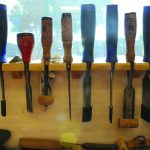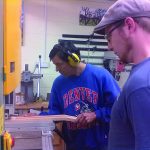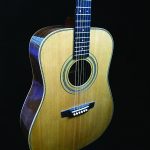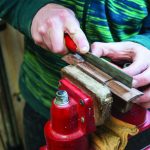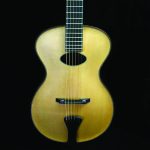Luthiers’ Fancy: Binford Luthiery
Luthiers’ Fancy: Binford Luthiery
The business seemed to rather creep into place on the Auckland guitar-making (and repair) scene, but in a couple of years Binford Luthiery has cemented a significant and active presence, which notably includes a beginner school of luthiery. NZM’s guitar guru, Mark Bell, headed to Onehunga to meet Trevor Binford and investigate his growing luthiery business.
We’re told that the human brain can be broadly categorised as one of two main types – the ‘classical’ brain is said to be scientific, organised, methodical, pragmatic, mathematical, while the ‘romantic’ brain is more intuitive, creative, impulsive and artistic.
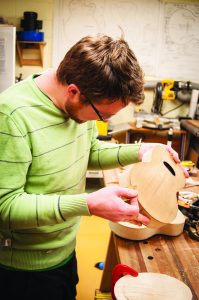 I’m no expert, but let’s throw in chaotic and needy with addictive tendencies. This is why luthiers are such a rare and special breed, because to be truly gifted in their craft (or should I say ‘art’?) they need to have copious facility in both categories.
I’m no expert, but let’s throw in chaotic and needy with addictive tendencies. This is why luthiers are such a rare and special breed, because to be truly gifted in their craft (or should I say ‘art’?) they need to have copious facility in both categories.
For sure there is a fair chunk of exacting mathematical and engineering mental and physical dexterity required to produce a great-sounding instrument; measuring loads, devising complex bracing systems and neck joints, routing and drilling and any number of complex and exacting tasks that sit squarely in the ‘engineering’ box.
But to truly transcend the parameters of science you need to tap into something much more unquantifiable and mysterious, and that is where the true artistry of instrument building begins. Trevor Binford is one of those luthiers who manage this mental balancing act of seamlessly marrying art to craft with the skill of an all-but-invisible neck joint.
Specialising in jazz archtop guitars, he produces a range of custom handmade stringed instruments, also building (and repairing) acoustic flat tops, ukuleles and electric guitars. He’s a busy man, as this story will reveal, so I was tasked with finding out as much as it’s possible to absorb in one evening about the mysterious art of bespoke instrument building.
Driving to Binford Luthiery’s workshop in an industrial sector of Auckland’s Onehunga, I had a mental picture of him as a thick-set Kiwi, plaid-encased forearms like Christmas hams, calloused hand crushing mine in greeting – “Gidday mate, beers in the fridge, come and see the workshop…”
Names, of course, are often deceiving and Trevor turns out to be a softly spoken, Michigan-born, Washington State-schooled, Alaskan life-experienced young man (he’s 30) with a wealth of high-end luthiery already under his belt – the results of which are hanging from the walls of the back room and speak to me as articulately as anything Trevor has to say over the next hour – which is quite a lot.
Unsure of what he wanted to do after graduating from school, the young Binford eventually got his start in the business by enrolling in a year-long masters course in guitar building and repair, in British Columbia. While there one phone call changed the trajectory of this budding young luthier’s life forever.
“When I was at guitar-building school one of my teachers, Mike Jarvis, got a call from Bob Benedetto who’s the biggest name in guitar building in the world when it comes to these particular guitars (arch tops). His instruments sell for US $40,000 each.”
(I nod knowingly as if to convey familiarity with this jaw-dropping revelation.)
“So he (Jarvis) says to me, ‘They need somebody down there, you can work in the States, and we like your work, so would you go?’ I had a couple of things to work out, but there was really no way around it, I had to take that job. There was no other opportunity in the world like that. So I went down to Georgia and worked with Bob Benedetto.”
“He’s a really hard-nosed Italian gentleman from New York, a real tough boss, but he was a really cool boss to have as well, a very good player. I just had a really good time waking up in the morning and working for the best guitar builder in the world for a couple of years.”
With US recession storm clouds gathering on the horizon he and his wife made the decision to move to NZ, staying with his wife’s family in Hawkes Bay and working the orchards for a couple of years until Trevor had accumulated enough money to tool up a small luthiery business. At that point they made the move to Auckland, and Binford Guitars began in earnest.
As I take in the well-appointed workshop my eye is drawn to a nicely contoured piece of timber soon to grace the top of an acoustic/electric arch top. I ask if it’s been steamed over a mould to acquire those complex curves.
“It isn’t. That’s carved, that’s why it’s called an acoustic arch top. Because there’s no sound properties in glue. To steam a piece of wood to a shape you have to have laminates to make it strong, then you have to have glue between each laminate to hold it together. Well that’s a lot of glue when you have three sheets of timber with glue in-between. There are no acoustic properties to it. When you hit a string that top will vibrate some, but if you go through the process of carving it out of an inch-thick piece of wood then you have a lot more sound.”
The tools he uses for this exacting task are marvellously old school – devilishly sharp small brass hand-planes, one of which is not much bigger than your thumb. He says these tools allow him to work at a pace that feels right to him. They remove the right amount of material with each stroke to allow him to gradually conjure the curves he is looking for. You might think this would be the most time consuming aspect of arch top building, but Trevor mentions later that sculpting the top and back takes him about five hours these days, while the total guitar build time comes to around a month.
I ask whether he likes to incorporate any NZ timbers in his beautiful designs.
“For certain things yes, although with a lot of the timbers it’s hard to find ones that are dried properly and processed properly. So when people want to buy an acoustic guitar I don’t reinvent the wheel usually, I just use standards like mahogany and spruce – I don’t go down that route. For certain things I have, like for neck timbers I’ve used swamp kauri and it hasn’t moved at all, however I’ve reinforced it with carbon fibre and laminated it a couple of times. I use it with discretion.”
Discretion seems to fit the Binford design philosophy rather well – you won’t find lashings of paua inlays, ornate bindings and wildly exotic timbers.
“That’s somebody else’s gift, not my own. I find the simpler the better.”
What you will find are masterpieces of balanced design, visually appealing in a beautifully understated way –instruments that look and sound like they belong up there with the very best, which they doubtless do.
While our interview is going on a young man is intently sanding away in the background. He’s not an assistant but in fact a student – the third leg to the Binford Luthiery’s building, repair and teaching platform – his Guitar Buildshop.
“What I offer and what’s really taken off are courses for acoustic and electric guitar building. So people sign up and we go through all the processes required to come out with an acoustic guitar or electric guitar. There will be flaws in the end but it will be a playable, nice-sounding instrument that they were very much a part of making. I show processes and I help them and I do some of it myself, but a lot of the grunt-work is done by them, and that brings them a step closer to the instrument and to the music.”
Surrounded as we are by such beautiful creations I have to ask whether he ever gets emotionally attached to certain instruments and consequently finds it a bit wrenching to let them go, in the knowledge he will probably never see them again. He admits that in the early days he did.
“If I have that real appreciation for that instrument I’ve just created, it’s something I want to share, it’s something I want to sell on to somebody. I want somebody else to appreciate that as well, I want them to invest themselves emotionally the same way I have.”
“You should never glorify the inanimate object too much, because it’s the person holding it that really makes it sing.”
Hard to say if that’s ‘classic’ brain or ‘romantic’ brain that came up with that pearl, but I suspect it’s from both.


